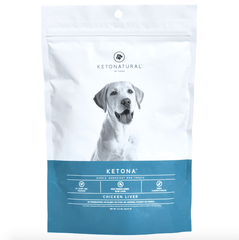Save Money, Save Your Dog.
Join Our Email List For Discounted Pricing and a Free Guide to the Science of Keto Dog Food.
Learn Why Continuous Glucose Monitors Are A Game Changer For Parents of Diabetic Dogs and Cats

Canine diabetes is a disease characterized by a dog's inability to properly regulate her blood glucose. This is a hugely significant problem because high levels of blood glucose are acutely toxic for dogs. Left unchecked, lingering high glucose will cause horrible damage, even death.
Unfortunately, canine blood glucose levels fluctuate naturally throughout the day, spiking with particular ferocity after the ingestion of carbohydrate-rich meals. Fortunately, most dogs can manage glucose spikes just fine. Because their bodies produce a substance called insulin, a hormone whose job is to bring glucose levels back under control by shuttling it out of the blood and into fat cells and other places where it can be stored stably.
Healthy dogs do this well. They are able to produce enough insulin to keep their blood glucose from ever reaching acutely toxic levels. But diabetic dogs do it poorly. So when a diabetic dog eats a carbohydrate-rich meal, her blood glucose remains dangerously high unless and until someone provides her with enough exogenous insulin to make up the shortfall.
This means there are at least two reasons why diabetic dog owners might want to measure and monitor their pets' glucose levels.
The first is to make decisions regarding insulin dosing. Exogenous insulin is expensive; all else being equal, a pet owner will want to use as little of it as possible to keep their dog healthy. And, very roughly speaking, the more glucose that's in a diabetic dog's blood, the more exogenous insulin she'll need. So determining how much glucose is in the animal's bloodstream can help pet parents make appropriate insulin dosing decisions.
A second reason why diabetic dog owners might want to monitor their pets' glucose levels: to help make better dietary choices for the animal. Different foods will raise canine blood glucose levels to different degrees. And understanding precisely how different products impact your dog's blood glucose will allow you to make the best dietary decisions you can, given your budget and other considerations.
Until recently, the only reliable way to measure a dog's glucose was with a device called a glucometer (at the time of writing, the Alphatrak 2 is the most popular one).
They're pretty simple little tools but they've got some drawbacks. For one, they require that you literally draw your dog's blood, a process which is at best inconvenient and likely a source of significant stress. Moreover, they only measure glucose at a single moment in time. So if you're interested in understanding how glucose levels are changing over time (or how high they reach at peak concentration), you're going to be taking numerous readings (i.e., drawing blood repeatedly). Not ideal.
But an exciting new technological advancement has changed the game and in my humble opinion every diabetic pet parent should at the least give it some consideration.
Continuous glucose monitors (CGMs) are nifty little digital devices consisting of two components, a sensor and a transmitter. Adhesive is used to stick the device onto the skin, where the sensor measures glucose levels continuously and the transmitter broadcasts those levels off to a handheld reader, which displays the data in real-time.
This means that CGMs represent upgrades over traditional glucometers in two fundamental ways. First, they measure glucose levels continuously, not at a single moment in time. Secondly, they pull their readings from interstitial fluid just under the surface of the skin, not the blood.
That's right. Real-time, continuous glucose readings, all without skin pricks and without blood draws.
The first CGMs started showing up right around the turn of the century. But the FDA only validated them for use with human beings, not companion animals. In fact, to this day, there are still no CGMs that have been created specifically for use with dogs or cats.
But a recent study published in Journal of Veterinary Internal Medicine has shown that the most popular human-use CGM (Abbott's Freestyle Libre) actually works just as well with dogs as it does with humans. According to a team of researchers from the University of Bologna, the Freestyle Libre was "painless, easy, and well-tolerated" within a group of ten diabetic dogs. And each device provided glucose readings that were remarkably accurate for the entirety of its 14-day lifespan.
It seems inevitable that CGMs are going to rapidly advance the scientific community's understanding of canine diabetes. And it's hard to see how the popular (but absurd) notion that a prescription-only kibble with 40% carbohydrate is the best food to feed a diabetic dog is going to survive. Slowly but surely CGM-based experiments are going to demonstrate that carbohydrate minimization is the most effective dietary treatment for diabetic dogs. You can take that to the bank.
But what about pet owners who can't wait for all that? What about the folks who need to manage their dog's diabetes right now? Do we all have to sit around and wait for some medical device company to roll out a canine-use CGM?
Nope, we sure don't. In fact, if you want to understand how to acquire and use a CGM with your diabetic dog, I can help with that too. Check out my step-by-step guide to buying and setting up a canine CGM.

Related Articles
How Much Does The Farmer’s Dog Really Cost?
5 Signs and Symptoms That Your Dog May Have Diabetes
Learning to Take Pleasure In Being Your Dog's Play Buddy-Drill Sargeant
Dogs, Dog Food and Dogma - A Book About America's Pet Obesity Epidemic
Browse Articles By Category